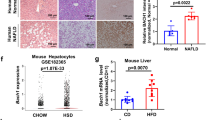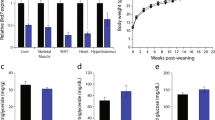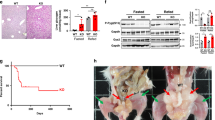Abstract
Reduced hepatic expression levels of bromodomain-containing protein 7 (BRD7) have been suggested to play a role in the development of glucose intolerance in obesity. However, the molecular mechanism by which BRD7 regulates glucose metabolism has remained unclear. Here, we show that BRD7 increases phosphorylation of glycogen synthase kinase 3β (GSK3β) in response to activation of the insulin receptor-signaling pathway shortly after insulin stimulation and the nutrient-sensing pathway after feeding. BRD7 mediates phosphorylation of GSK3β at the Serine 9 residue and this effect on GSK3β occurs even in the absence of AKT activity. Using both in vitro and in vivo models, we further demonstrate that BRD7 mediates phosphorylation of ribosomal protein S6 kinase (S6K) and leads to increased phosphorylation of the eukaryotic translation initiation factor 4E-binding protein 1 (4E-BP1) and, therefore, relieves its inhibition of the eukaryotic translation initiation factor 4E (eIF4E). However, the increase in phosphorylation of 4E-BP1 with BRD7 overexpression is blunted in the absence of AKT activity. In addition, using liver-specific BRD7 knockout (LBKO) mice, we show that BRD7 is required for mTORC1 activity on its downstream molecules. These findings show a novel basis for understanding the molecular dynamics of glucose metabolism and suggest the unique function of BRD7 in the regulation of glucose homeostasis.







Similar content being viewed by others
Abbreviations
- BRD7:
-
Bromodomain-containing protein 7
- GSK3β:
-
Glycogen synthase kinase 3β
- 4E-BP1:
-
Eukaryotic translation initiation factor 4E-binding protein 1
- eIF4E:
-
Eukaryotic translation initiation factor 4E
- NPC:
-
Nasopharyngeal carcinoma
- BRCA-1:
-
Breast cancer susceptibility gene 1
- PI3K:
-
Phosphatidylinositol 3-kinase
- XBP1s:
-
The spliced form of X-box binding protein 1
- ER:
-
Endoplasmic reticulum
- IR:
-
Insulin receptor
- IRS1:
-
Insulin receptor substrate 1
- IRS2:
-
Insulin receptor substrate 2
- AKT:
-
Protein kinase B
- GS:
-
Glycogen synthase
- TSC2:
-
Tuberous sclerosis protein 2
- GAP:
-
GTPase-activating protein
- mTORC:
-
Mammalian target of rapamycin (mTOR)-raptor complex
- S6K:
-
Ribosomal protein S6 kinase
- Pfu:
-
Plaque forming unit
- MEF:
-
Mouse embryonic fibroblasts
- KO:
-
Knockout
- LBKO:
-
Liver-specific BRD7 knockout mouse model
- FoxO1:
-
Forkhead box O1
References
Zhou J, Ma J, Zhang BC, Li XL, Shen SR, Zhu SG, Xiong W, Liu HY, Huang H, Zhou M, Li GY (2004) BRD7, a novel bromodomain gene, inhibits G1-S progression by transcriptionally regulating some important molecules involved in ras/MEK/ERK and Rb/E2F pathways. J Cell Physiol 200(1):89–98. https://doi.org/10.1002/jcp.20013
Liu H, Zhang L, Niu Z, Zhou M, Peng C, Li X, Deng T, Shi L, Tan Y, Li G (2008) Promoter methylation inhibits BRD7 expression in human nasopharyngeal carcinoma cells. BMC Cancer 8:253. https://doi.org/10.1186/1471-2407-8-253
Kaeser MD, Aslanian A, Dong MQ, Yates JR 3rd, Emerson BM (2008) BRD7, a novel PBAF-specific SWI/SNF subunit, is required for target gene activation and repression in embryonic stem cells. J Biol Chem 283(47):32254–32263. https://doi.org/10.1074/jbc.M806061200
Peng C, Liu HY, Zhou M, Zhang LM, Li XL, Shen SR, Li GY (2007) BRD7 suppresses the growth of nasopharyngeal carcinoma cells (HNE1) through negatively regulating beta-catenin and ERK pathways. Mol Cell Biochem 303(1–2):141–149. https://doi.org/10.1007/s11010-007-9466-x
Harte MT, O’Brien GJ, Ryan NM, Gorski JJ, Savage KI, Crawford NT, Mullan PB, Harkin DP (2010) BRD7, a subunit of SWI/SNF complexes, binds directly to BRCA1 and regulates BRCA1-dependent transcription. Cancer Res 70(6):2538–2547. https://doi.org/10.1158/0008-5472.CAN-09-2089
Mantovani F, Drost J, Voorhoeve PM, Del Sal G, Agami R (2010) Gene regulation and tumor suppression by the bromodomain-containing protein BRD7. Cell Cycle 9(14):2777–2781. https://doi.org/10.4161/cc.9.14.12309
Drost J, Mantovani F, Tocco F, Elkon R, Comel A, Holstege H, Kerkhoven R, Jonkers J, Voorhoeve PM, Agami R, Del Sal G (2010) BRD7 is a candidate tumour suppressor gene required for p53 function. Nat Cell Biol 12(4):380–389. https://doi.org/10.1038/ncb2038
Burrows AE, Smogorzewska A, Elledge SJ (2010) Polybromo-associated BRG1-associated factor components BRD7 and BAF180 are critical regulators of p53 required for induction of replicative senescence. Proc Natl Acad Sci USA 107(32):14280–14285. https://doi.org/10.1073/pnas.1009559107
Chiu YH, Lee JY, Cantley LC (2014) BRD7, a tumor suppressor, interacts with p85alpha and regulates PI3K activity. Mol Cell 54(1):193–202. https://doi.org/10.1016/j.molcel.2014.02.016
Park SW, Herrema H, Salazar M, Cakir I, Cabi S, Basibuyuk Sahin F, Chiu YH, Cantley LC, Ozcan U (2014) BRD7 regulates XBP1s’ activity and glucose homeostasis through its interaction with the regulatory subunits of PI3K. Cell Metab 20(1):73–84. https://doi.org/10.1016/j.cmet.2014.04.006
Unanue ER, Urano F (2014) Endoplasmic reticulum: an interface between the immune system and metabolism. Diabetes 63(1):48–49. https://doi.org/10.2337/db13-1478
Oakes SA, Papa FR (2015) The role of endoplasmic reticulum stress in human pathology. Annu Rev Pathol 10:173–194. https://doi.org/10.1146/annurev-pathol-012513-104649
Park SW, Ozcan U (2013) Potential for therapeutic manipulation of the UPR in disease. Semin Immunopathol 35(3):351–373. https://doi.org/10.1007/s00281-013-0370-z
Park SW, Zhou Y, Lee J, Ozcan U (2010) Sarco(endo)plasmic reticulum Ca2+-ATPase 2b is a major regulator of endoplasmic reticulum stress and glucose homeostasis in obesity. Proc Natl Acad Sci USA 107(45):19320–19325. https://doi.org/10.1073/pnas.1012044107
Fruman DA (2010) Regulatory subunits of class IA PI3K. Curr Top Microbiol Immunol 346:225–244. https://doi.org/10.1007/82_2010_39
Yu J, Zhang Y, McIlroy J, Rordorf-Nikolic T, Orr GA, Backer JM (1998) Regulation of the p85/p110 phosphatidylinositol 3′-kinase: stabilization and inhibition of the p110alpha catalytic subunit by the p85 regulatory subunit. Mol Cell Biol 18(3):1379–1387. https://doi.org/10.1128/MCB.18.3.1379
Birney DM, Cole DC, Crosson CE, Kahl BF, Neff BW, Reid TW, Ren K, Walkup RD (1995) Use of beta-methylphenylalanine (beta MeF) residues to probe the nature of the interaction of substance P with its receptor: effects of beta MeF-containing substance P analogs on rabbit iris smooth muscle contraction. J Med Chem 38(13):2478–2482. https://doi.org/10.1021/jm00013a024
Jope RS, Yuskaitis CJ, Beurel E (2007) Glycogen synthase kinase-3 (GSK3): inflammation, diseases, and therapeutics. Neurochem Res 32(4–5):577–595. https://doi.org/10.1007/s11064-006-9128-5
Rayasam GV, Tulasi VK, Sodhi R, Davis JA, Ray A (2009) Glycogen synthase kinase 3: more than a namesake. Br J Pharmacol 156(6):885–898. https://doi.org/10.1111/j.1476-5381.2008.00085.x
Sarbassov DD, Guertin DA, Ali SM, Sabatini DM (2005) Phosphorylation and regulation of Akt/PKB by the rictor-mTOR complex. Science 307(5712):1098–1101. https://doi.org/10.1126/science.1106148
Inoki K, Li Y, Zhu T, Wu J, Guan KL (2002) TSC2 is phosphorylated and inhibited by Akt and suppresses mTOR signalling. Nat Cell Biol 4(9):648–657. https://doi.org/10.1038/ncb839
Manning BD, Logsdon MN, Lipovsky AI, Abbott D, Kwiatkowski DJ, Cantley LC (2005) Feedback inhibition of Akt signaling limits the growth of tumors lacking Tsc2. Genes Dev 19(15):1773–1778. https://doi.org/10.1101/gad.1314605
Ising C, Koehler S, Brahler S, Merkwirth C, Hohne M, Baris OR, Hagmann H, Kann M, Fabretti F, Dafinger C, Bloch W, Schermer B, Linkermann A, Bruning JC, Kurschat CE, Muller RU, Wiesner RJ, Langer T, Benzing T, Brinkkoetter PT (2015) Inhibition of insulin/IGF-1 receptor signaling protects from mitochondria-mediated kidney failure. EMBO Mol Med 7(3):275–287. https://doi.org/10.15252/emmm.201404916
Laplante M, Sabatini DM (2012) mTOR signaling in growth control and disease. Cell 149(2):274–293. https://doi.org/10.1016/j.cell.2012.03.017
Ma XM, Blenis J (2009) Molecular mechanisms of mTOR-mediated translational control. Nat Rev Mol Cell Biol 10(5):307–318. https://doi.org/10.1038/nrm2672
Jefferies HB, Fumagalli S, Dennis PB, Reinhard C, Pearson RB, Thomas G (1997) Rapamycin suppresses 5′TOP mRNA translation through inhibition of p70s6k. EMBO J 16(12):3693–3704. https://doi.org/10.1093/emboj/16.12.3693
Pende M, Kozma SC, Jaquet M, Oorschot V, Burcelin R, Le Marchand-Brustel Y, Klumperman J, Thorens B, Thomas G (2000) Hypoinsulinaemia, glucose intolerance and diminished beta-cell size in S6K1-deficient mice. Nature 408(6815):994–997. https://doi.org/10.1038/35050135
Zhang HH, Lipovsky AI, Dibble CC, Sahin M, Manning BD (2006) S6K1 regulates GSK3 under conditions of mTOR-dependent feedback inhibition of Akt. Mol Cell 24(2):185–197. https://doi.org/10.1016/j.molcel.2006.09.019
Raught B, Gingras AC (1999) eIF4E activity is regulated at multiple levels. Int J Biochem Cell Biol 31(1):43–57. https://doi.org/10.1016/S1357-2725(98)00131-9
Hay N, Sonenberg N (2004) Upstream and downstream of mTOR. Genes Dev 18(16):1926–1945. https://doi.org/10.1101/gad.1212704
Nojima H, Tokunaga C, Eguchi S, Oshiro N, Hidayat S, Yoshino K, Hara K, Tanaka N, Avruch J, Yonezawa K (2003) The mammalian target of rapamycin (mTOR) partner, raptor, binds the mTOR substrates p70 S6Kinase and 4E-BP1 through their TOR signaling (TOS) motif. J Biol Chem 278(18):15461–15464. https://doi.org/10.1074/jbc.C200665200
Kim Y, Andres Salazar Hernandez M, Herrema H, Delibasi T, Park SW (2016) The role of BRD7 in embryo development and glucose metabolism. J Cell Mol Med 20(8):1561–1570. https://doi.org/10.1111/jcmm.12907
Lochhead PA, Coghlan M, Rice SQ, Sutherland C (2001) Inhibition of GSK-3 selectively reduces glucose-6-phosphatase and phosphatase and phosphoenolypyruvate carboxykinase gene expression. Diabetes 50(5):937–946. https://doi.org/10.2337/diabetes.50.5.937
Zhang X, Zhao F, Si Y, Huang Y, Yu C, Luo C, Zhang N, Li Q, Gao X (2014) GSK3beta regulates milk synthesis in and proliferation of dairy cow mammary epithelial cells via the mTOR/S6K1 signaling pathway. Molecules 19(7):9435–9452. https://doi.org/10.3390/molecules19079435
Embi N, Rylatt DB, Cohen P (1980) Glycogen synthase kinase-3 from rabbit skeletal muscle. Separation from cyclic-AMP-dependent protein kinase and phosphorylase kinase. Eur J Biochem 107(2):519–527. https://doi.org/10.1111/j.1432-1033.1980.tb06059.x
Matsumoto T, Nagase Y, Hirose J, Tokuyama N, Yasui T, Kadono Y, Ueki K, Kadowaki T, Nakamura K, Tanaka S (2013) Regulation of bone resorption and sealing zone formation in osteoclasts occurs through protein kinase B-mediated microtubule stabilization. J Bone Miner Res 28(5):1191–1202. https://doi.org/10.1002/jbmr.1844
Salas TR, Reddy SA, Clifford JL, Davis RJ, Kikuchi A, Lippman SM, Menter DG (2003) Alleviating the suppression of glycogen synthase kinase-3beta by Akt leads to the phosphorylation of cAMP-response element-binding protein and its transactivation in intact cell nuclei. J Biol Chem 278(42):41338–41346. https://doi.org/10.1074/jbc.M302972200
Eldar-Finkelman H (2002) Glycogen synthase kinase 3: an emerging therapeutic target. Trends Mol Med 8(3):126–132. https://doi.org/10.1016/S1471-4914(01)02266-3
Song G, Ouyang G, Bao S (2005) The activation of Akt/PKB signaling pathway and cell survival. J Cell Mol Med 9(1):59–71. https://doi.org/10.1111/j.1582-4934.2005.tb00337.x
Carnero A, Blanco-Aparicio C, Renner O, Link W, Leal JF (2008) The PTEN/PI3K/AKT signalling pathway in cancer, therapeutic implications. Curr Cancer Drug Targets 8(3):187–198. https://doi.org/10.2174/156800908784293659
Altomare DA, Testa JR (2005) Perturbations of the AKT signaling pathway in human cancer. Oncogene 24(50):7455–7464. https://doi.org/10.1038/sj.onc.1209085
Lu M, Wan M, Leavens KF, Chu Q, Monks BR, Fernandez S, Ahima RS, Ueki K, Kahn CR, Birnbaum MJ (2012) Insulin regulates liver metabolism in vivo in the absence of hepatic Akt and Foxo1. Nat Med 18(3):388–395. https://doi.org/10.1038/nm.2686
Marte BM, Downward J (1997) PKB/Akt: connecting phosphoinositide 3-kinase to cell survival and beyond. Trends Biochem Sci 22(9):355–358
Dalle Pezze P, Sonntag AG, Thien A, Prentzell MT, Godel M, Fischer S, Neumann-Haefelin E, Huber TB, Baumeister R, Shanley DP, Thedieck K (2012) A dynamic network model of mTOR signaling reveals TSC-independent mTORC2 regulation. Sci Signal 5(217):ra25. https://doi.org/10.1126/scisignal.2002469
Acknowledgements
We are indebted to Dr. U. Ozcan for reagents and helpful discussions. Research reported in this publication was supported by the National Institute of Diabetes and Digestive and Kidney Diseases of the National Institutes of Health under Award number R00DK093788. The content is solely the responsibility of the authors and does not necessarily represent the official views of the NIH. This work was also supported by the American Diabetes Association/Innovative Basic Science Grant (1-17-IBS-104), Boston Children’s Hospital Office of Faculty Development/BTREC/CTREC Faculty Career Development fellowship, and the Division of Endocrinology, Boston Children’s Hospital/Faculty Start up fund provided to S. W. P.
Author information
Authors and Affiliations
Corresponding author
Electronic supplementary material
Below is the link to the electronic supplementary material.
18_2017_2711_MOESM1_ESM.eps
Supplementary material 1 (EPS 2395 kb) Figure S1. Quantification of BRD7 levels in liver tissues by qPCR analysis. (A–C) BRD7 mRNA levels in the liver were quantified through qPCR and normalized to 18S. (A) 7-week-old C57/BL6 J wild-type male mice were injected with Ad-BRD7 or Ad-LacZ as a control at a plaque forming unit (pfu) of 8 x 106 (n = 3 for each virus) through the tail vein. (B) 7-week-old BRD7 TgCre+/− mice and BRD7 TgCre−/−. (C) 7-week-old wild-type mice were injected with Ad-LacZshRNA or Ad-BRD7shRNA at a pfu of 8 x 106 (n = 6 for each virus) through the tail vein. Error bars are represented as mean ± SEM; P values were determined by Student’s t test. (*p < 0.05, **p < 0.01, ***p < 0.001)
Rights and permissions
About this article
Cite this article
Golick, L., Han, Y., Kim, Y. et al. BRD7 regulates the insulin-signaling pathway by increasing phosphorylation of GSK3β. Cell. Mol. Life Sci. 75, 1857–1869 (2018). https://doi.org/10.1007/s00018-017-2711-x
Received:
Revised:
Accepted:
Published:
Issue Date:
DOI: https://doi.org/10.1007/s00018-017-2711-x




